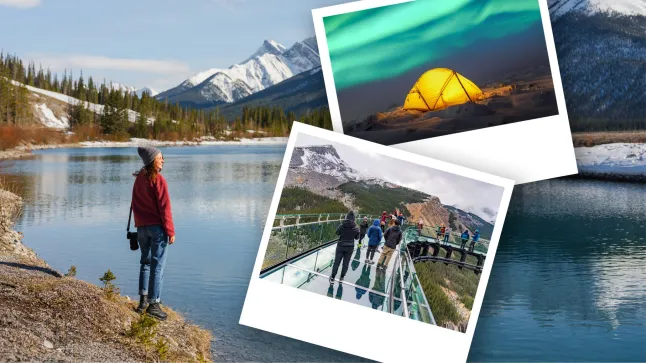Travel
Coolcation: The Hottest Trend in Travel for 2025 – Discover the Best Destinations – Travel And Tour World

Thursday, December 12, 2024
In 2024, traditional summer travel to destinations like Italy, Spain, and Greece saw a shift as travelers opted for cooler climates, giving rise to the term “coolcation.” This emerging trend, expected to dominate 2025, encourages holidaymakers to explore destinations offering lower temperatures, breathtaking natural landscapes, and unique cultural experiences.
The move away from summer hotspots stems from several factors, including climate change, overcrowded tourist attractions, and growing awareness of alternative travel destinations. Here’s a look at some of the top coolcation destinations gaining popularity.
Banff, Canada: A Natural Wonderland
Located in Alberta, Banff offers stunning Rocky Mountain peaks, vibrant turquoise glacial lakes, and vast coniferous forests. A significant uptick in flight searches to Banff and Lake Louise has cemented its place as a must-visit destination for nature enthusiasts. Visitors can hike, canoe, and ice skate on Lake Louise, or try their hand at skijoring, a thrilling winter sport.
In summer, Banff enjoys pleasant highs of 22°C, while winter temperatures dip to an average low of -15°C, making it ideal for skiing and snowboarding. Banff’s pristine wilderness and activities cater to adventurers and families alike.
Sweden: Lapland’s Arctic Charm
Sweden remains a popular destination, especially for those chasing the Northern Lights. Cities like Luleå and Piteå in Swedish Lapland provide access to the Arctic Circle, while Abisko is renowned for its clear skies, offering one of the best chances to witness the aurora borealis. The midnight sun in summer adds another layer of magic to these remote locations.
Visitors to Sweden can enjoy cultural experiences in Stockholm and lesser-known towns like Abisko, where Sámi culture and reindeer herding provide unique, enriching experiences.
Finland: The Aurora and Sámi Culture
Expedia reports a 705% increase in flight searches to Finnish Lapland, reflecting the destination’s rising appeal. Beyond viewing the Northern Lights, Finland offers endless opportunities for adventure. From snowboarding and skiing in winter to hiking and swimming in the summer, visitors can immerse themselves in nature while learning about the Sámi, the EU’s only indigenous people. Tourists can also witness reindeer migration and participate in cultural traditions, making Finnish Lapland a captivating destination year-round.
Alaska, USA: Wilderness and Wildlife
Alaska saw a record-breaking 2 million summer visitors in 2023, a 20% increase from pre-pandemic figures. The state’s breathtaking landscapes include Denali National Park, home to North America’s tallest peak, and Glacier Bay National Park, which can be explored by cruise or private boat. For wildlife enthusiasts, remote destinations like Ketchikan offer unique encounters with Alaskan nature.
Summer in Alaska offers nearly 24 hours of daylight, while winter brings opportunities to witness the Northern Lights. Average temperatures range from 15°C in Southcentral Alaska during summer to an icy -35°C in the Far North, making Alaska a versatile destination for outdoor adventures.
Eastern Europe: Affordable Coolcations
Eastern Europe is emerging as a hotspot for coolcations, offering affordability, cultural diversity, and cooler climates. According to Tourism Economics, the region is expected to see a 7.5% annual growth in tourism over the next five years.
Cities like Vilnius in Lithuania, crowned Europe’s most affordable city in 2024, are attracting budget-conscious travelers. Other top destinations include Krakow, Riga, Budapest, and Prague, all of which combine rich history, stunning architecture, and reasonable prices. Eastern Europe’s cooler summers and cultural treasures make it an ideal alternative to Western Europe’s more crowded hotspots.
Challenges of the Coolcation Trend
While coolcations offer unique experiences, the surge in popularity poses challenges for smaller destinations. Norway and Denmark have struggled with traffic congestion as motorhome drivers flood rural areas, while Scotland’s NC500 route has faced criticism for overcrowding and misuse of single-track roads. The influx of tourists can strain local infrastructure, leading to growing concerns among residents.
Why Coolcations are Here to Stay
Coolcations cater to travelers seeking escape from extreme heat, crowded beaches, and environmental concerns. The emphasis on sustainable and meaningful travel aligns with shifting consumer preferences, making this trend likely to grow in popularity. As travelers continue to explore cooler, less-traveled destinations, they also contribute to diversifying tourism economies worldwide.
Top Coolcation Destinations for 2025
- Banff, Canada: Known for its turquoise glacial lakes and outdoor activities.
- Swedish Lapland: A gateway to the Arctic Circle and the Northern Lights.
- Finnish Lapland: Adventure, Sámi culture, and aurora borealis experiences.
- Alaska, USA: A wilderness haven with glaciers, wildlife, and stunning national parks.
- Eastern Europe: Affordable cities like Vilnius and Krakow with rich cultural offerings.
Conclusion
The coolcation trend reflects a shift in traveler preferences toward sustainable, adventurous, and culturally immersive experiences. Destinations in colder climates like Canada, Scandinavia, Alaska, and Eastern Europe are gaining popularity, offering alternatives to traditional summer hotspots. As climate change and overcrowding impact tourism, coolcations provide a refreshing approach to travel.









